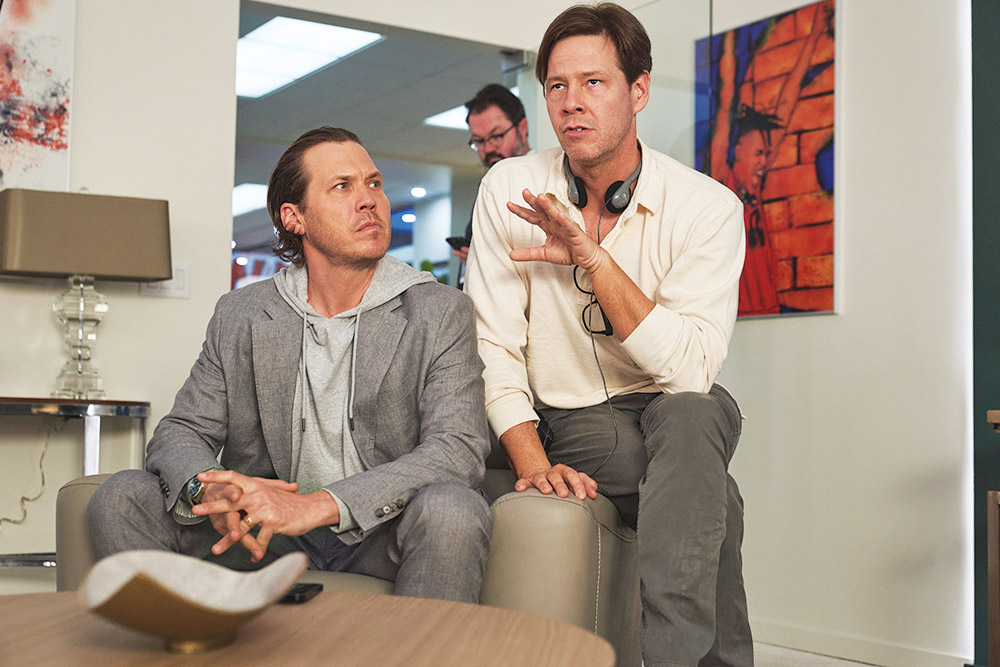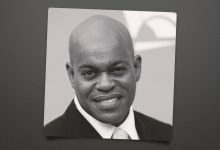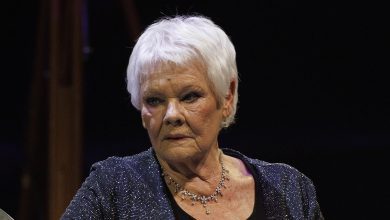Ike Barinholtz Jokes He’s “Lucky to Be Alive” After Driving WIth ‘The Studio’ Costar Seth Rogen

Ike Barinholtz is everywhere. In the past few months, he has captivated audiences by playing Continental Studios executive Sal Saperstein in Apple TV+’s The Studio, but he’s also made moves behind the camera as co-creator, exec producer and writer on Netflix’s Running Point. The two projects somewhat overlapped, which Barinholtz admits was “intense. But that’s what I signed up for.”
Here, the actor delves into his preparation for The Studio, known for its long takes, and how Running Point, based on the life story of Lakers president Jeanie Buss, had its own unique challenges.
Your work on Running Point and The Studio overlapped a bit, right? What was that experience like?
Yes, Running Point started maybe six weeks beforehand, but there was definitely an overlap. I’d never done that to that extent, for an extended period of time. I’m so lucky to have the partners that I have in Dave Stassen and Mindy Kaling and to have to work for guys like Seth Rogen and Evan Goldberg, who just make it easy, and they make it so when you roll into one place, you know exactly what’s going on. It was intense, but hey, that’s what I signed up for.
In terms of The Studio, Seth Rogen wrote Sal Saperstein for you. What were those early conversations with him like?
He called me many years ago, and he was like, “I love The Larry Sanders Show. Evan Goldberg and I are doing a show about showbiz, and we’re writing a part for you. Would you do it?” And it was a very easy yes. The Larry Sanders Show is one of my favorite shows of all time, and I’ve never really gotten a chance to do anything that really puts an eye on this business. But things happen where someone will say something to you, and then the show never materializes, or they end up making it with someone else, so I just said, “I’m in.” Every six months or so, he would call me and be like, “You’re in, right?” And I was like, “It’s your show, dude!” But then at some point, Dave [Stassen, showrunner] and I were approached by Mindy [Kaling] to come on Running Point. And then a year later, we were rolling [on Running Point].
How did your career in Hollywood prepare you for the role, given that you’ve had experience with studio executives?
The key to making it in Hollywood is being OK with endless rejection, disappointment, moments of great joy and excitement surrounded by nightmarish anxiety. I have been very lucky to be a writer and a producer, and I have dealt with a lot of executives on the other side of it, and the vast majority are smart and nice people who really just want the movie to be as good as possible while keeping their job. I had a lot to tap into when it came to putting Sal together. I came into this business in the 2000s, which was a crazy time, where you had the excess and bad behavior left over from the ’90s, but you also had incredible yield. You had incredible comedy. I had seen a lot of executives come and go, and I tried to find someone who made their bones in that era and is still around, so they got to experience the excess and bad behavior of the 2000s but then have made it through the “awakenings” of the 2010s and ’20s. Sal’s just a guy who’s partied and done it all and been in multiple threesomes at Sundance over the years, but now in 2025 he understands there are certain things you have to change, otherwise you won’t last.
What is Sal’s day like when he’s not working?
I think every other weekend he spends with his daughters. I definitely believe that after work, he is a martini guy. I think he could do an espresso martini if he would find himself at a brunch, but he’s an old-school, normal, Vesper-ish martini guy. I could see Sal five nights a week going to Dan Tana’s or Spago or Sushi Park. I could see him spending a lot of time throwing down the silver Amex. If I had to go out five nights a week, I would just die. He also probably joined some weird private gym where he just sits and reads The New York Times.
What would’ve been Sal’s bar mitzvah theme?
Sal’s bar mitzvah was in 1990 and would have had a theme of a film from that year, so maybe Home Alone? Possible chance his dad got Daniel Stern [who played Marv the burglar] to come.
The show has some extraordinary continuous takes — what was that like for you being in front of the camera?
Seth driving is just … I’m just lucky to be alive. I’m just praying in multiple different languages and religious tomes to make it through that scene. He’s a very good driver, but he’s a very fast driver, and we’re driving cars that were built in, like, 1959. You think affable, sweet, Jewish Canadian stoner. But no, he wants to go fast. He should be in a Fast & Furious movie. As Seth Rogen. At some point, Vin [Diesel]’s character, Dom Toretto, is like, “There’s only one guy we could call, and it’s Seth Rogen. He’s mishpocha,” which is Yiddish for family. But no, to prepare to do this was unlike anything I’d done in my life.
What was your most challenging scene?
One of the first scenes I shot was [with] Chase Sui Wonders, which was a very big, emotional one. I’m going from screaming to crying to being grateful. Also, I didn’t know Chase, we had just literally met, and she’s such a sweet young lady, and she’s like, “Nice to meet you. I’m a big fan.” And then an hour later, I’m just in her face, like, “You loser!” I would say the stuff in Vegas toward the end was rough. We shot for basically two weeks, every day, long hours, and we’re shooting on a live casino floor late at night and dragging nude Bryan [Cranston] through the lobby of The Venetian.
Were people in the casino trying to approach you all?
We had a great crew that had a lot of spotters, but I mean, you’re going through a packed casino floor with Seth Rogen, Bryan Cranston, Catherine O’Hara and Kathryn Hahn. Everyone likes at least one of them, if not all of them. I like to gamble a bit, and when we’d do hair and makeup, you’d have 20 minutes until you have to be on set, and I would just kind of walk past a blackjack table. I was playing, and Cranston walks past, and he’s like, “What are you up? What are you down?” And the dealer froze. He’s like, “Was that Bryan Cranston?” And I was like, “Yeah,” and he goes, “Your Honor is the greatest show I’ve ever seen.” And I was like, “Yeah, it’s amazing. And Breaking Bad!” He goes, “Never seen it.” There is a guy out there who’s like, “My favorite actor, Bryan Cranston, Your Honor.”
The show has amazing guest stars — was there a standout for you? Other than your dad.
Obviously, my dad! It’s impossible to pick just one. Martin Scorsese is a very important person in my life, and I never thought I would get to work with him, let alone act with him, so that was surreal. … Every day there was a new person where you’re like, “I can’t believe I’m sitting in a sprinter van with Ron Howard.” It’ll be interesting, for season two, who do you get? How do you top it? You’ve got to get Tom Hanks or something.

After a day of intense filming, what was your way to decompress?
When you’re acting, especially all day in every scene, it is nice to come home and, at least I try, to watch like a half hour of either a TV show or a basketball game or something. But for this show, I would come home and have to instantly go into my office and work on my lines for the next day, so when I show up, I’m prepared. But it is a bit of a must that if I get home before 10 o’clock, a basketball game is really nice. Vegas was interesting because in L.A., you wrap at 8:30 pm. People are like, “bye, see you guys tomorrow.” In Vegas, you wrap and you’re standing in front of a martini bar and Catherine O’Hara is like, “does anyone want a martini?” We did get to unwind a little bit after shooting some of those long days in Vegas with a drink or two, or in some cases, seven.
In terms of Running Point, I know there was a different creative team involved first and you joined later.
Initially, Mindy came to Dave and I with the idea, and we, at the time, were knee deep doing History of the World Part II with Mel Brooks. And we were bummed, because we for years were like, we got to figure out a thing to do with Mindy again, just because we love her so much. She’s so funny. We just kind of missed each other, which happens. And then by the time we had finished History, she came back, and she was like, “Hey, we’re trying something new.” We sat down and talked about what we thought the show could be and then we pitched it and I think Warners and Netflix saw the path we wanted to go. Before you know, we were back in Mindy’s office ordering humongous Italian sub sandwiches just like the old days.
How did you collaborate with Jeanie Buss and Linda Rambis, given that the show is based on Jeanie’s story?
I’ve been lucky enough to know them for a few years, and they really are two of the nicest people I’ve ever met. They gave us unprecedented access, where they would let us come to the training center in El Segundo. Walking around the locker room, Austin Reaves came out in a towel and was like, “Oh, shucks y’all, nice to meet you.” … We knew the tone we wanted, and we knew a little bit of how we wanted Isla [played by Kate Hudson] to be, but hanging with Jeanie and seeing how her employees react to her, and how they interact with each other, really informed a lot, because they love her and she loves them. That informed the writing, because we wanted the characters to be flawed. We love Succession, and we love how they just constantly shit on each other, but we really wanted to make sure there was a big undercurrent of love, and seeing that firsthand really helped us. … I’ll never forget, the first day we did our camera test, and Kate walks out. She’s got the hair with the little bangs, and she’s got the skirt with the blouse tucked, and the lanyard. And I was like, “It’s Jeanie.”
Kate and Jeanie have known each other since Kate was little. Did their relationship aid the storytelling?
I think when I hear both those names, Kate Hudson and Jeanie Buss, I think of Southern California. I think they just kind of emerged from the Pacific Ocean and walked onto the beach, whether it’s Manhattan Beach or the Palisades or wherever. I didn’t know [they knew each other], I was just like, that makes the binding ties stronger. … It’s amazing when you think about the lives both these women have led, and the fact that now one is kind of playing a version inspired by the other is just delicious.
What challenges did you face?
Shooting basketball is hard and very expensive. We knew this was a comedy about a family that owns a basketball team, and not about players. At first, I was like, “How are we going to shoot basketball? We’re not able to fill an arena, and we don’t have the budget that, say, a Winning Time has.” But Dave Stassen brilliantly made the choice to make it feel almost like a Nike commercial from the mid-’90s. … TV budgets are just not what they used to be, so envisioning a show that was supposed to be very big, and still making it look beautiful and cool, but not having all the tools to have it, is something that was challenging at times, but I think we did it.
Source: Hollywoodreporter
HiCelebNews online magazine publishes interesting content every day in the TV section of the entertainment category. Follow us to read the latest news.
Related Posts
- Inaugural Pride LIVE! Hollywood Fest Expands Lineup With Music Events, Screenings and More
- Locarno Unveils Open Doors Program Projects, Producers for First Edition of Africa Focus
- Savannah Guthrie Recalls Leaving Her Delivery Room ‘Trashed,’ Chilling Wine in the Hospital Urinal
- George Clooney-Produced Ohio State Abuse Doc Gets Date, Trailer From HBO
- Ginny & Georgia Star Antonia Gentry Is Turning Delusions Into Reality





